The First Conference on Atmospheric Biogeosciences last month in Boston was introduced to broaden the scope of the long-running AMS Conference on Agricultural and Forest Meteorology, now at its 30th meeting. Together, the joint specialty meetings brought in a record number of nearly 200 attendees. According to Ankur Desai, Chair of the AMS Committee on Agricultural and Forest Meteorology, this first joint meeting attracted a whole new audience, with many attendees experiencing their first AMS conference of any kind. Loretta J. Mickley, atmospheric chemist, member of the Board on Atmospheric Biogeosciences, and a conference co-chair, was one of them. “The joint meeting promised to bring together scientists from a range of disciplines,” Mickley comments. “I found the mix of issues enriching.”
The recently initiated AMS Board on Atmospheric Biogeosciences, chaired by Elizabeth Pattey, worked to broaden the focus of the Agricultural and Forest Meteorology meeting, by bringing in the atmospheric chemistry and ecology communities. The meeting featured presentations over four days, covering aspects of the dynamic exchanges occurring at the interface between the atmosphere and the Earth’s surface, such as canopy transport and dispersion, the fate of environmental mercury, and methane emissions from managed and unmanaged landscapes. According to Desai, it turned out to be a great fit. “It was clear from the beginning that there is a natural partnership between the two communities. We sat right at the intersection of where micrometeorology met macroecology.”
Ian Strachan, co-chair of conference and member of the AMS Committee on Agricultural and Forest Meteorology, agrees, noting that by infusing a rich tradition of meetings that goes back to the 1950s with joint sessions from the Board brought these communities together in a way that allowed attendees to explore new connections and avenues of research. Pattey, points out how the smaller venue was ideal for these types of interactions. “By integrating members in a more intimate setting, it opens a new area of direction, allowing collaborations and ideas that are important in establishing stronger ties within and between the two groups,” she comments.
Strachan noted how the sessions also provided an opportunity for students to present their work at a major venue, many for the first time. And according to the chairs, the significant number of talks (~40) and posters (~20) presented by graduate students points to atmospheric biogeosciences as a strong emerging field.
With the positive feedback from attendees, the committee and conference chairs are already discussing another joint meeting. “We plan to continue the tradition from here, bringing in scientists from even more disciplines to add to the diversity of research that was presented at this meeting,” concludes Desai.
 Rachel
Rachel
Small Microbes Play Big in Climate Arena
Microbes may be small, but they shouldn’t be ignored when considering global climate. According to a new colloquium report from The American Academy of Microbiology, microbes such as bacteria, algae, and fungi play a powerful role in the Earth’s climate. “Incorporating Microbial Processes into Climate Models” notes how the impact of microbes on the atmosphere goes way back in time. The critical mix of carbon dioxide and oxygen we take for granted as sustaining life on the planet is due to the rise of these tiny creatures eons ago.
So what specifically do these minute forms of life have to do with climate today? According to the report, the answer is plenty. “The sum total of their activity is enormous. But of course not all microbes are the same—some of them are producing oxygen, others are consuming it. Some are taking carbon dioxide out of the air, others are adding it.”
The big questions that the report asks and plans to address by incorporating microbial processes into climate change models: what’s the overall effect of microbial activities on the concentration of carbon dioxide in the atmosphere? Is it possible this activity will absorb the carbon dioxide being added to the atmosphere? Or will the rising global temperature might spur microbes to produce even more carbon dioxide?
The authors recognize that the gap between the climatology and microbiology is large, but they say it is not insurmountable. Some of the same technologies used to collect data for climate models—satellite imaging of cloud cover and precipitation, submarine cables that monitor changes in temperature and salinity, sensors to retrieve real-time data from remote locations—can also be applied to measuring biological phenomena. Collaboration between the sciences, they believe, will benefit both fields.
A more detailed look at the report is available here.
Big Exhibits in the Big Easy
More photos up on Flickr.
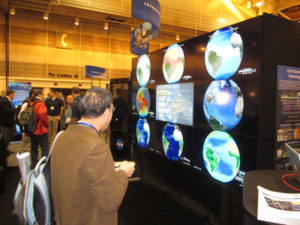
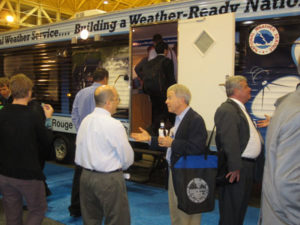
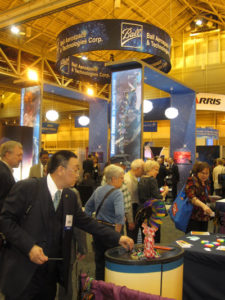
WeatherFest and All That Jazz
More photos up on Flickr.
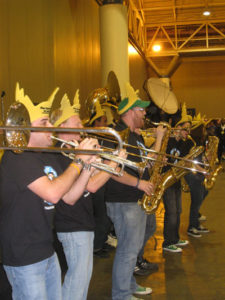
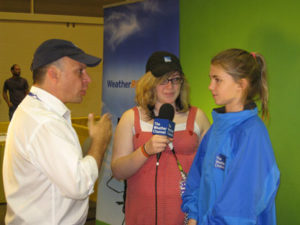

Get Your Meeting Photo Fix
After you check The Front Page, Twitter, Facebook, and the AMS YouTube channel for the latest happenings at the Annual Meeting, make sure to take a look at the photos on Flickr.
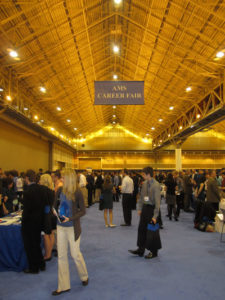
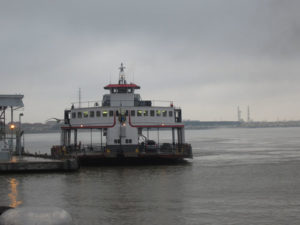
For more shots of the Career Fair and scenes around town, take a look here. Make sure to check back daily to see the latest events.
Weather Alerts Get More (and More) Mobile
The use of social media as a forecast tool seems to develop as rapidly as the devices themselves. In December, the NWS revealed it will soon be providing customized location-specific alerts through a user’s wireless carrier.
“We’re getting this weather, disaster, and other emergency information into your hand,” says David Green of the NWS. “The new service will use geo-location to target alerts to a person’s whereabouts. The goal is to give people greater insight into what’s going on with the weather so they can make the best decisions about how to respond.”
At the AMS Meeting in New Orleans next month, you can get a look at two more ways mobile devices are being used to aid in forecasts. In “Using Mobile Devices to Display, Overlay, and Animate Meteorological Data and Imagery,” David Santek, CIMSS/University of Wisconsin, and colleagues, will show their custom interfaces for smartphones that offer near real-time weather alerts. For more on the details of their applications and the future plans for it, check out their presentation on Monday, 23 January, at 5:00 p.m. (Room 357).
Marcel Molendijk, of the Royal Netherlands Meteorological Institute, offers up a different use in “iWitness; Damage Assessment of Severe Weather by Mobile (phone) Observations.” Instead of sending weather alerts to cell phone users, Moldendijk and colleagues collected accident damage reports from an Apple iOS application they developed, with information including a description of the event, time and location (GPS-based), and an optional photo. To get more information on the KNMI system and the results collected to date, go to the talk on Tuesday, 24 January at 2:30 p.m. (Room 356).
iPhone Game Puts Satellite Data in Your Hands
The Los Angeles Times compares it to Tetris and calls it “the nerdiest game ever“. As far as we’re concerned, that’s a sure-fire journalistic badge of honor for Satellite Insight, the new iPhone game app from NASA and NOAA.
The object of the new game is to control real-time Earth and space weather data. Colored blocks falling into columns on a grid represent small pieces of data. To save lives and protect expensive instruments, the GOES-R weather satellite must not lose any data. Players bundle like data types together before the grid overflows. Data blocks fall slowly at first, but arrive faster as the game continues. Each speed-up also brings a power-up tool you can use at any time to help clear the grid. Keep it going as long as you can and try to beat your best time. Explains NASA’s web site:
No matter how thirsty you are, it’s not easy to drink from a fire hose. But that’s similar to the challenge of capturing and storing the huge blast of images and information that the new GOES-R weather satellite will gather.
And of course, as a NASA and NOAA product, the game has an educational mission too–the instructions include information about the upcoming real-life GOES-R satellite.
Satellite Insight is available free for iPhone and other iOS devices on iTunes. Check it out here.
Weather and Climate Services Protecting Public Health: Get Your Questions Answered
by Viviane Silva, Co-Chair, Third Conference on Environment and Health
To address the needs related to reducing climate-weather-water related public health risks, we’ve organized a panel session entitled “Integration of Climate-Weather-Water and Health Information: Strengthening Partnerships and Enhancing Services” during the Third Conference on Environment and Health at the AMS 2012 in New Orleans (Monday 23 January, 4 p.m., Room 333). Taking part in the discussion will be a distinguished group of experts, including: Dr. Jack Hayes, director of the National Weather Service; Dr. Christopher Portier, director of the National Center for Environmental and Health for Toxic Substances and Disease Registry – CDC; Dr. John Balbus, senior advisor for Public Health, National Institute of Environmental Health Sciences – NIH; and Dr. John Haynes, NASA, Health and Air Quality Applications Program Manager. This is your chance to participate as well.
The topics will include research and data needs, opportunities for shared efforts, and emerging services to support decision makers in the health community. The presenters plan to focus on
- the changing landscape of society’s need for integrated information to enhance decision making and each agency contribution to this regarding climate, weather, and water information to predict, prevent, or manage public health risks;
- how CDC, NIH, NOAA, and NASA will work collaboratively with other agencies to address national, state, local, and tribal needs;
- how these agencies will support open exchange of data and delivery of information and decision tools; and
- current efforts to facilitate research and development of services.
The presentations are designed to foster a conversation with the audience. Some of the questions the presenters plan to ask are: What integrated weather/water/climate/health information do you need? What challenges do you face when trying to access data that you need? What would you envision being included in a related Decision Support System or Health Early Warning System? Considering the current fiscal environment, what integrated information would you consider to be the highest priority?
We’re looking for more questions from you. Post your questions as comments to this entry on The Front Page and we’ll make sure
they will be answered during the panel discussion.
AMS Climate Course To Reach 100 More Minority-Serving Institutions
The AMS Education Program has been awarded a grant by the National Science Foundation (NSF) to implement the AMS Climate Studies course at 100 minority-serving institutions (MSIs) over a five-year period. The project will focus on introducing and enhancing geoscience coursework at MSIs nationwide, especially those that are signatories to the American College & University Presidents’ Climate Commitment (ACUPCC) and/or members of the Louis Stokes Alliances for Minority Participation. AMS is partnering with Second Nature, the non-profit organization administering the ACUPCC.
“This national network involves more than 670 colleges and universities who are committed to eliminating net greenhouse gas emissions from campus operations by promoting the education and research needed for the rest of society to do the same,” explains Jim Brey, director of the AMS Education Program. “AMS and Second Nature will work together to demonstrate to current and potential MSI signatories how AMS Climate Studies introduces or enhances sustainability-focused curricula.”
In the first four years of the project, AMS will hold a weeklong AMS Climate Studies course implementation workshops for about 25 MSI faculty members. The annual workshops will feature scientists from NOAA, NASA Goddard Space Flight Center, University of Maryland, Howard University, George Mason University, and other Washington, DC area institutions. Faculty will initially offer AMS Climate Studies in the year following workshop attendance and colleges that successfully implement AMS Climate Studies will be encouraged to build a focused geoscience curricula area by also offering AMS Weather Studies and AMS Ocean Studies.
“The major outcomes of this project will be a large network of faculty trained as change agents in their institutions, sustained offering of AMS undergraduate courses within MSIs, and the introduction of thousands of MSI students to the geosciences,” comments Brey. He notes that this project builds on the success of similar NSF-supported programs for MSI faculty implementing the AMS Weather Studies and AMS Ocean Studies courses, which together have reached 200 MSIs and over 18,000 MSI students. “We’re looking forward to working with Second Nature to continue to expand the climate course and the education that it represents.”
Weather-Ready or Not, Here We Come
The year so far has been expensive when it comes to disasters. Make that record-breaking expensive. According to NOAA, with nine separate big-money disasters, the losses have already reached $35 billion. In response, the NWS—in partnership with other government agencies, researchers, and the private sector—is building a plan to make the country “Weather-ready.” Earlier this week, officials from various agencies participated in a group discussion with the goal of understanding the threats extreme weather poses today and what can be done about it. Specifically, they want people nationwide to develop plans they can implement quickly to protect themselves when severe weather strikes.
“Building a Weather-ready nation is everyone’s responsibility,” comments Eddie Hicks, U.S. Council of International Association of Emergency Managers (IAEM USA) president. “It starts with the NWS and emergency managers, like IAEM USA, but it ends with action by individuals and businesses to reduce their risks. The more prepared communities are for destructive weather, the less of a human and economic toll we’ll experience in the future, and that’s a great thing for the country.”
The discussion resulted in a list of necessities to make a Weather-ready nation. They include improved precision of weather and water forecasts and effective communication of risk to local authorities; improved weather decision support services with new initiatives such as the development of mobile-ready emergency response specialist teams; strengthening joint partnerships to enhance community preparedness; and working with weather enterprise partners and the emergency management community to enhance safety and economic output and effectively manage environmental resources.
John Malay, president of the AMS, took part in the announcement and emphasized that the partnership among the three weather sectors—all represented in the AMS membership—is essential in achieving the vision. “We share the mission of informing and protecting our citizens, which is what this enterprise and initiative are all about,” he comments. “Given the resources to grow our scientific understanding of our complex environment through observations and research and to apply this knowledge in serving society, we can do amazing things together.”
You can download a pdf copy of the NWS Strategic Plan for this initiative from the Weather-ready nation website.